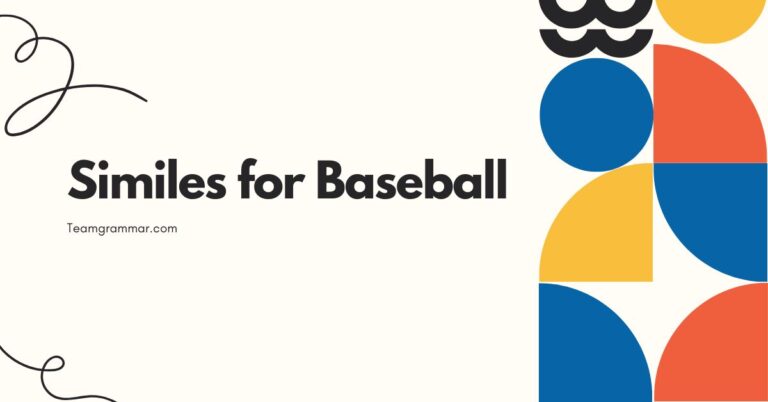29 Similes for Old: Enhancing Expression in English
Understanding and using similes effectively adds depth and color to our language. When describing someone or something as “old,” similes provide a vivid and relatable comparison that goes beyond simple adjectives.
This article delves into the world of similes for “old,” exploring their structure, various categories, usage rules, and common mistakes. Whether you’re an English language learner, a writer seeking to enrich your prose, or simply curious about the nuances of language, this guide will equip you with the knowledge and tools to master similes for “old.” By the end of this article, you’ll be able to craft more expressive and engaging descriptions, bringing your language to life.
Table of Contents
- Introduction
- Definition of Simile
- Structural Breakdown of Similes
- Types of Similes for “Old”
- Examples of Similes for “Old”
- Usage Rules for Similes
- Common Mistakes with Similes
- Practice Exercises
- Advanced Topics: Nuances and Subtleties
- Frequently Asked Questions
- Conclusion
Introduction
The English language is rich with figurative language, and similes are a cornerstone of this richness. They allow us to paint vivid pictures with words, making our descriptions more engaging and memorable.
When describing age, whether it’s the age of a person, an object, or an idea, similes offer a nuanced way to convey the passage of time and its effects. This article focuses specifically on similes used to describe “old,” providing a comprehensive guide to their structure, usage, and impact.
By mastering these similes, you can elevate your writing and speaking, adding depth and color to your communication.
This guide is designed for learners of all levels, from beginners to advanced speakers. We will break down the concept of similes into manageable components, providing numerous examples and practical exercises to reinforce your understanding.
Whether you are preparing for an exam, writing a story, or simply seeking to improve your language skills, this article will provide you with the tools and knowledge you need to confidently use similes for “old.” So, let’s embark on this journey of linguistic exploration and discover the power of similes in enhancing our descriptions of age.
Definition of Simile
A simile is a figure of speech that directly compares two different things using the words “like” or “as.” The purpose of a simile is to create a vivid image or emphasize a particular quality of one thing by associating it with something else that is familiar or easily understood. It’s a powerful tool for writers and speakers to add color, depth, and clarity to their language.
Unlike metaphors, which imply a direct equivalence (“He is a lion”), similes acknowledge that the two things being compared are distinct but share a common characteristic (“He is braveasa lion”). This distinction is crucial for understanding the function and impact of similes in language.
Similes serve to make abstract or complex concepts more concrete and relatable by drawing parallels to tangible or well-known entities.
In the context of describing “old,” similes allow us to go beyond simple adjectives and evoke a sense of history, wear, fragility, or wisdom. For example, saying someone is “as old as the hills” conveys a sense of great age and permanence in a more evocative way than simply saying they are “very old.” Similes can also be used to create a specific tone or mood, depending on the comparison being made.
The choice of simile can significantly impact the reader’s perception and understanding of the subject being described.
Classification
Similes fall under the broader category offigurative language, which encompasses any expression that deviates from the literal meaning of words in order to achieve a particular effect. Other types of figurative language include metaphors, personification, hyperbole, and irony.
Similes are specifically classified as figures of comparison because they explicitly draw a parallel between two different things.
Within the realm of similes, there are various ways to further classify them based on their structure, purpose, or the specific qualities they emphasize. For instance, some similes may focus on physical appearance, while others may highlight behavioral traits or emotional states.
The classification of a simile often depends on the context in which it is used and the specific effect the writer or speaker intends to create.
Function
The primary function of a simile is to enhance description and make it more engaging. By comparing something to something else, similes can help readers or listeners visualize the subject more clearly and understand its qualities more deeply.
Similes can also be used to evoke emotions, create a particular mood, or add humor to a piece of writing or speech. They are a versatile tool that can be used in a variety of contexts to achieve a range of effects.
In the context of describing “old,” similes can be used to convey a sense of age, history, wear, fragility, wisdom, or resilience. The specific function of the simile will depend on the comparison being made and the overall tone and purpose of the communication.
For example, a simile that compares an old person to a “wise owl” emphasizes their wisdom and experience, while a simile that compares an old house to a “crumbling ruin” highlights its state of disrepair.
Contexts
Similes are used in a wide range of contexts, from literature and poetry to everyday conversation and advertising. They are particularly common in descriptive writing, where they can be used to bring scenes and characters to life.
Similes are also frequently used in persuasive writing and speeches to make arguments more compelling and relatable. In everyday conversation, similes can add color and humor to our interactions.
When describing “old,” similes can be used in a variety of contexts, depending on the subject being described and the desired effect. For example, in a historical novel, similes might be used to describe the age of a building or the appearance of an elderly character.
In a personal essay, similes might be used to reflect on the passage of time and the changes that come with age. In a humorous anecdote, similes might be used to exaggerate the effects of aging for comedic effect.
Structural Breakdown of Similes
A simile, at its core, consists of three essential components: the subject, the linking word, and the object of comparison. Understanding these components is crucial for constructing effective and meaningful similes.
Let’s break down each of these components:
- The Subject: This is the thing being described. In our focus on “old,” the subject could be a person, an object, a place, or even an idea that possesses the quality of being old.
- The Linking Word: This is the word that establishes the comparison. The most common linking words are “like” and “as.” These words signal that the subject and the object of comparison share a common characteristic.
- The Object of Comparison: This is the thing that the subject is being compared to. It should be something that is familiar or easily understood, and that possesses the quality that is being emphasized in the subject.
For example, in the simile “He is as old as the hills,” “He” is the subject, “as” is the linking word, and “the hills” is the object of comparison. The simile suggests that the person being described is very old, as hills are perceived to be ancient and enduring.
Patterns and Rules
While the basic structure of a simile is relatively simple, there are some patterns and rules to keep in mind when constructing them. These guidelines can help ensure that your similes are clear, effective, and appropriate for the context in which they are used.
Clarity:The comparison should be clear and easily understood. The connection between the subject and the object of comparison should be obvious to the reader or listener.
Avoid using obscure or overly complex comparisons that may confuse or distract from your message.
Relevance:The object of comparison should be relevant to the subject and the quality being emphasized. The comparison should make sense in the context of the overall message.
Avoid using comparisons that are illogical or nonsensical.
Originality: While some similes are common and widely used, striving for originality can make your writing or speech more engaging and memorable. Consider using unique or unexpected comparisons that will capture the attention of your audience.
Appropriateness: The simile should be appropriate for the tone and purpose of the communication. Avoid using similes that are offensive, insensitive, or otherwise inappropriate for the context in which they are used.
Types of Similes for “Old”
Similes for “old” can be categorized based on the specific aspect of age they emphasize. Here are a few common categories:
Age and Longevity
These similes emphasize the sheer length of time something has existed. They often use comparisons to things that are perceived as ancient or enduring.
Wear and Tear
These similes highlight the physical effects of age, such as decay, damage, or deterioration. They often use comparisons to things that are worn, broken, or dilapidated.
Wisdom and Experience
These similes focus on the positive aspects of age, such as knowledge, insight, and understanding. They often use comparisons to things that are associated with wisdom, such as owls, books, or ancient trees.
Fragility and Vulnerability
These similes emphasize the delicate or vulnerable nature of something that is old. They often use comparisons to things that are easily broken, damaged, or destroyed.
Examples of Similes for “Old”
Here are some examples of similes for “old,” organized by category:
Age and Longevity Examples
The following table provides examples of similes that emphasize age and longevity. Each example uses a comparison to something perceived as old or enduring to highlight the subject’s age.
| Simile | Explanation |
|---|---|
| As old as the hills | Implies extreme age, as hills are perceived as ancient. |
| As old as time | Suggests something has existed for a very long time, possibly since the beginning of time. |
| As old as the pyramids | Compares age to the ancient pyramids, known for their historical significance. |
| As old as the dinosaurs | Highlights great age, referencing the prehistoric era of dinosaurs. |
| As old as Methuselah | Refers to the biblical figure Methuselah, known for his exceptionally long life. |
| As ancient as the stars | Suggests an age comparable to the vastness and age of the universe. |
| As venerable as an ancient oak | Emphasizes age and respect, comparing to a long-lived and respected tree. |
| As timeless as a classic tale | Highlights the enduring nature of something, like a story that remains relevant through the ages. |
| As antique as a museum piece | Compares age to valuable artifacts preserved in museums. |
| As aged as fine wine | Suggests that age has improved its quality, like well-aged wine. |
| As seasoned as an old mariner | Implies age and experience gained over a long period. |
| As historical as a landmark | Highlights age and significance, similar to a famous historical site. |
| As enduring as a mountain range | Compares age to the lasting presence of mountains. |
| As dateless as the ocean | Suggests an age beyond measure, like the timeless ocean. |
| As fossilized as ancient remains | Emphasizes an age comparable to preserved fossils. |
| As primordial as the earth | Suggests something is as old as the origins of the planet. |
| As ageless as a myth | Implies that something is unaffected by time, like a timeless myth. |
| As perennial as a recurring dream | Highlights the recurring nature of something, suggesting it has existed for a long time. |
| As time-worn as an artifact | Compares age to the wear and tear on an ancient artifact. |
| As weathered as an old sailor’s face | Suggests age and experience marked by time and exposure. |
| As established as a long-standing tradition | Implies a tradition has been in place for a very long time. |
| As ancient as hieroglyphics | Compares age to the ancient written language of hieroglyphics. |
| As venerable as a historical document | Highlights age and respect, similar to an important historical record. |
Wear and Tear Examples
The following table provides examples of similes that emphasize wear and tear. These similes use comparisons to things that are worn, damaged, or deteriorated to highlight the effects of age.
| Simile | Explanation |
|---|---|
| Like a worn-out shoe | Implies something is old and damaged from extensive use. |
| Like a dilapidated building | Suggests something is in a state of disrepair due to age and neglect. |
| Like a faded photograph | Highlights the loss of vibrancy and clarity over time. |
| Like a rusty hinge | Emphasizes the stiffness and difficulty in movement due to age and corrosion. |
| Like a cracked vase | Suggests fragility and damage, indicating something is likely to break. |
| Like a tattered flag | Highlights the wear and tear from exposure to the elements. |
| Like a moth-eaten tapestry | Implies damage and decay, suggesting the object is falling apart. |
| Like a crumbling wall | Emphasizes the gradual disintegration and instability due to age. |
| Like a threadbare carpet | Suggests excessive wear and thinning from prolonged use. |
| Like a weathered stone | Highlights the effects of time and the elements, resulting in a worn appearance. |
| Like a peeling painting | Implies deterioration and the loss of original beauty. |
| Like a dented can | Suggests damage and imperfection from being handled roughly. |
| Like a scratched record | Highlights the loss of quality and the presence of imperfections. |
| Like a leaky faucet | Emphasizes the inefficiency and wastefulness due to age and wear. |
| Like a faded tattoo | Suggests the loss of vibrancy and definition over time. |
| Like a brittle bone | Implies fragility and susceptibility to breaking. |
| Like a rusty tool | Highlights the loss of functionality due to corrosion and neglect. |
| Like a torn page | Suggests damage and incompleteness, indicating something is missing. |
| Like a creaking door | Emphasizes the noise and difficulty in movement due to age and wear. |
| Like a tarnished coin | Highlights the loss of luster and shine over time. |
| Like a faded sign | Implies the loss of visibility and clarity due to exposure. |
| Like a worn path | Suggests extensive use and the effects of repeated foot traffic. |
| Like a patched tire | Highlights the need for repair and the temporary nature of the fix. |
Wisdom and Experience Examples
The following table provides examples of similes that emphasize wisdom and experience. These similes use comparisons to things associated with knowledge, insight, and understanding to highlight the positive aspects of age.
| Simile | Explanation |
|---|---|
| As wise as an owl | Compares wisdom to the traditional symbol of knowledge and insight. |
| Like a seasoned traveler | Suggests experience and knowledge gained from extensive journeys. |
| Like an ancient sage | Highlights wisdom and understanding acquired over a long life. |
| Like a well-read book | Implies a wealth of knowledge and stories accumulated over time. |
| Like a wise elder | Emphasizes the respect and wisdom associated with older members of a community. |
| Like a guiding star | Suggests the ability to provide direction and insight based on experience. |
| Like a deep well | Implies a vast reservoir of knowledge and understanding. |
| Like a learned scholar | Highlights expertise and knowledge gained through extensive study. |
| Like a seasoned general | Suggests strategic thinking and experience in leadership. |
| Like an experienced craftsman | Emphasizes skill and expertise honed over years of practice. |
| Like a knowing glance | Implies understanding and insight without the need for words. |
| Like a seasoned diplomat | Highlights the ability to navigate complex situations with skill and diplomacy. |
| Like an old growth forest | Suggests a rich and diverse ecosystem of knowledge and experience. |
| Like a time-tested recipe | Implies reliability and success based on years of refinement. |
| Like a master artisan | Highlights exceptional skill and creativity developed over a lifetime. |
| Like a seasoned judge | Suggests fairness and impartiality based on years of experience. |
| Like a wise mentor | Emphasizes the ability to guide and advise others based on knowledge and experience. |
| Like a seasoned politician | Highlights experience in navigating complex political landscapes. |
| Like a well-traveled map | Suggests a comprehensive understanding of different places and cultures. |
| Like an ancient library | Implies a vast collection of knowledge and wisdom accumulated over time. |
Fragility and Vulnerability Examples
The following table provides examples of similes that emphasize fragility and vulnerability. These similes use comparisons to things that are easily broken, damaged, or destroyed to highlight the delicate nature of something old.
| Simile | Explanation |
|---|---|
| As fragile as glass | Implies something is easily broken or damaged. |
| As delicate as a flower | Suggests something is easily harmed or destroyed. |
| As brittle as dry leaves | Highlights the tendency to break or crumble easily. |
| As vulnerable as a newborn | Emphasizes the need for protection and care. |
| As thin as paper | Suggests something is easily torn or damaged. |
| As tender as a young sprout | Implies something is easily affected by harsh conditions. |
| As frail as a butterfly’s wing | Emphasizes the delicate and easily damaged nature of something. |
| As defenseless as a chick | Suggests a lack of protection and vulnerability to harm. |
| As breakable as thin ice | Highlights the risk of collapse or failure under pressure. |
| As delicate as lace | Implies intricacy and susceptibility to damage. |
| As fragile as an eggshell | Suggests something is easily cracked or broken. |
| As vulnerable as a hermit crab without its shell | Emphasizes the lack of protection and exposure to danger. |
| As brittle as old bones | Highlights the increased risk of fracture or breakage. |
| As delicate as spun sugar | Implies sweetness and beauty, but also extreme fragility. |
| As fragile as a dream | Suggests something is easily shattered or lost. |
| As vulnerable as a seedling | Emphasizes the need for nurturing and protection to survive. |
| As brittle as autumn leaves | Highlights the dryness and tendency to crumble with age. |
| As delicate as a snowflake | Implies uniqueness and susceptibility to melting or disappearing. |
| As fragile as antique china | Suggests value and beauty, but also the need for careful handling. |
| As vulnerable as an open wound | Emphasizes the susceptibility to infection and harm. |
Usage Rules for Similes
Using similes effectively requires understanding the rules that govern their proper use. While similes can add flair to your writing, incorrect usage can lead to confusion or awkward phrasing.
Here are some key rules to keep in mind:
- Use “like” or “as”: Similes always use the words “like” or “as” to make the comparison. Avoid using other words or phrases that might suggest a metaphor instead of a simile.
- Compare dissimilar things: The two things being compared should be different enough to make the comparison interesting and insightful. Comparing two things that are too similar defeats the purpose of using a simile.
- Ensure the comparison is clear: The connection between the two things being compared should be obvious to the reader or listener. Avoid using obscure or overly complex comparisons that may confuse your audience.
- Maintain consistency: Once you establish a simile, maintain consistency in your language and imagery. Avoid abruptly shifting to a different comparison or metaphor.
- Avoid clichés: While some common similes can be effective, overusing clichés can make your writing seem unoriginal and uninspired. Strive for fresh and creative comparisons that will capture the attention of your audience.
Exceptions and Special Cases
While the rules for using similes are generally straightforward, there are some exceptions and special cases to be aware of. These include:
- Negative similes: Similes can also be used to express what something is *not* like. For example, “He is not as young as he used to be.”
- Implied similes: In some cases, the linking word “like” or “as” may be omitted, but the comparison is still implied. For example, “The old house stood sentinel over the town,” implies that the house is like a sentinel, guarding the town.
Common Mistakes with Similes
Even experienced writers and speakers can make mistakes when using similes. Here are some common errors to watch out for:
| Incorrect | Correct | Explanation |
|---|---|---|
| He is old like an elderly man. | He is as old as an elderly man. | Using “as” instead of “like” is more grammatically correct in this context, although both are acceptable. However, the simile itself is weak, since it compares “old” to “elderly,” which is essentially the same thing. |
| She is old as a rock. | She is as old as the mountains. | “As” should be used instead of “like.” Also, comparing someone’s age to a “rock” is less evocative than comparing them to “mountains,” which suggests great age and endurance. |
| The car was old, similar to a rusty bucket. | The car was like a rusty bucket. | “Similar to” is not the correct construction for a simile. Use “like” or “as.” |
| He is old like I am. | He is as old as I am. | While “like” is sometimes used informally, “as” is the grammatically preferred choice for comparisons. |
| The house was old, it resembled an ancient tree. | The house was like an ancient tree. | The original sentence is not a simile but a statement. The corrected version uses “like” to create a simile. |
Practice Exercises
Test your understanding of similes with these practice exercises:
Exercise 1: Identifying Similes
Identify the similes in the following sentences:
| Question | Answer |
|---|---|
| 1. The antique clock was as old as the house itself. | As old as the house itself |
| 2. His memories were fading like an old photograph. | Like an old photograph |
| 3. She is a wise woman. | (No simile) |
| 4. The ancient tree stood like a sentinel over the forest. | Like a sentinel over the forest |
| 5. The weathered book was as fragile as glass. | As fragile as glass |
| 6. The old man’s hands were as gnarled as the roots of an ancient tree. | As gnarled as the roots of an ancient tree |
| 7. The dusty attic smelled of memories. | (No simile) |
| 8. The ancient manuscript was as delicate as a butterfly’s wing. | As delicate as a butterfly’s wing |
| 9. The old car sounded like a dying whale. | Like a dying whale |
| 10. The senior citizen was as spry as a young deer. | As spry as a young deer |
Exercise 2: Completing Similes
Complete the following similes with an appropriate comparison:
| Question | Answer |
|---|---|
| 1. As old as _____. | As old as the hills. |
| 2. Like a _____, worn by time. | Like a stone, worn by time. |
| 3. As fragile as _____. | As fragile as glass. |
| 4. As wise as _____. | As wise as an owl. |
| 5. Like a _____, creaking with age. | Like a house, creaking with age. |
| 6. As ancient as __________. | As ancient as the pyramids. |
| 7. Like a ____________, telling tales of the past. | Like a historian, telling tales of the past. |
| 8. As weathered as __________. | As weathered as an old sailor’s face. |
| 9. Like a __________, holding countless stories. | Like a library, holding countless stories. |
| 10. As timeless as __________. | As timeless as a classic novel. |
Exercise 3: Writing Your Own Similes
Write your own similes to describe the following:
- An old house
- An elderly person
- An antique book
- A weathered statue
- An ancient artifact
(Answers will vary. Here are some possible answers.)
- An old house: Like a forgotten memory, the old house stood silent and still.
- An elderly person: As wise as an old owl, the elderly person shared their life lessons.
- An antique book: The antique book was as fragile as a butterfly’s wing.
- A weathered statue: The weathered statue stood like a silent guardian, watching over the city.
- An ancient artifact: The ancient artifact was as old as time, whispering tales of forgotten civilizations.
Advanced Topics: Nuances and Subtleties
For advanced learners, understanding the nuances and subtleties of similes can elevate their writing to a new level. This involves considering the context, tone, and audience when choosing and crafting similes.
A simile that works well in one situation may be inappropriate in another.
For example, using humor in similes can be effective, but it’s important to ensure that the humor is appropriate for the audience and the topic. Similarly, using similes that are culturally specific can add depth and richness to your writing, but it’s important to be aware of the potential for misunderstanding if your audience is not familiar with the cultural reference.
Experimenting with unconventional comparisons can also create a powerful effect. Instead of relying on common similes, try to come up with unique and unexpected comparisons that will surprise and engage your readers.
The key is to be creative and thoughtful in your use of similes, always considering the impact they will have on your audience.
Frequently Asked Questions
- What is the difference between a simile and a metaphor?
A simile compares two things using “like” or “as,” while a metaphor implies that one thing *is* another. Similes are explicit comparisons, whereas metaphors are implicit.
- Can a simile be a cliché?
Yes, a simile can become a cliché if it is overused and loses its impact. It’s best to strive for originality.
- Is it okay to use similes in formal writing?
Yes, similes can be used in formal writing, but they should be used sparingly and with careful consideration of the tone and audience. Avoid using overly informal or colloquial similes in formal contexts.
- How can I make my similes more creative?
Think outside the box and try to come up with unexpected comparisons. Consider the specific qualities you want to emphasize and look for objects or concepts that share those qualities in a unique way. Brainstorming and experimentation can help you generate creative similes.
- What if I can’t think of a good comparison?
Start by identifying the key characteristics you want to emphasize. Then, brainstorm a list of things that share those characteristics. Don’t be afraid to explore unusual or unexpected comparisons. You can also consult a thesaurus or dictionary for inspiration.
- Are there any similes that should be avoided?
Avoid using similes that are offensive, insensitive, or otherwise inappropriate for the context in which they are used. Also, avoid using clichés or overused similes that have lost their impact.
- How do I know if a simile is effective?
An effective simile should be clear, relevant, and original. It should help the reader or listener visualize the subject more clearly and understand its qualities more deeply. If the simile is confusing, irrelevant, or unoriginal, it is likely not effective.
- Can similes be used in poetry?
Yes, similes are frequently used in poetry to create vivid imagery and enhance the emotional impact of the poem. They are a valuable tool for poets seeking to express complex ideas in a concise and evocative way.
- Is it better to use “like” or “as” in a simile?
Both “like” and “as” can be used in similes. “As” is often considered more formal, but both are grammatically correct. The choice depends on the specific context and the desired tone.
- How can I improve my understanding of similes?
Read widely and pay attention to how similes are used by different writers. Practice writing your own similes and experiment with different comparisons. Seek feedback from others and be open to constructive criticism. The more you practice, the better you will become at using similes effectively.
<
Conclusion
Similes are powerful tools for enriching language and enhancing expression, especially when describing the multifaceted concept of “old.” By understanding their structure, exploring different categories, adhering to usage rules, and avoiding common mistakes, you can effectively incorporate similes into your writing and speaking. Practice and experimentation will further refine your skills, allowing you to craft vivid and memorable descriptions.
Whether you aim to evoke a sense of longevity, highlight wear and tear, celebrate wisdom and experience, or emphasize fragility, similes offer a versatile means to add depth and color to your communication. Embrace the art of comparison and unlock the full potential of similes to bring your language to life.







